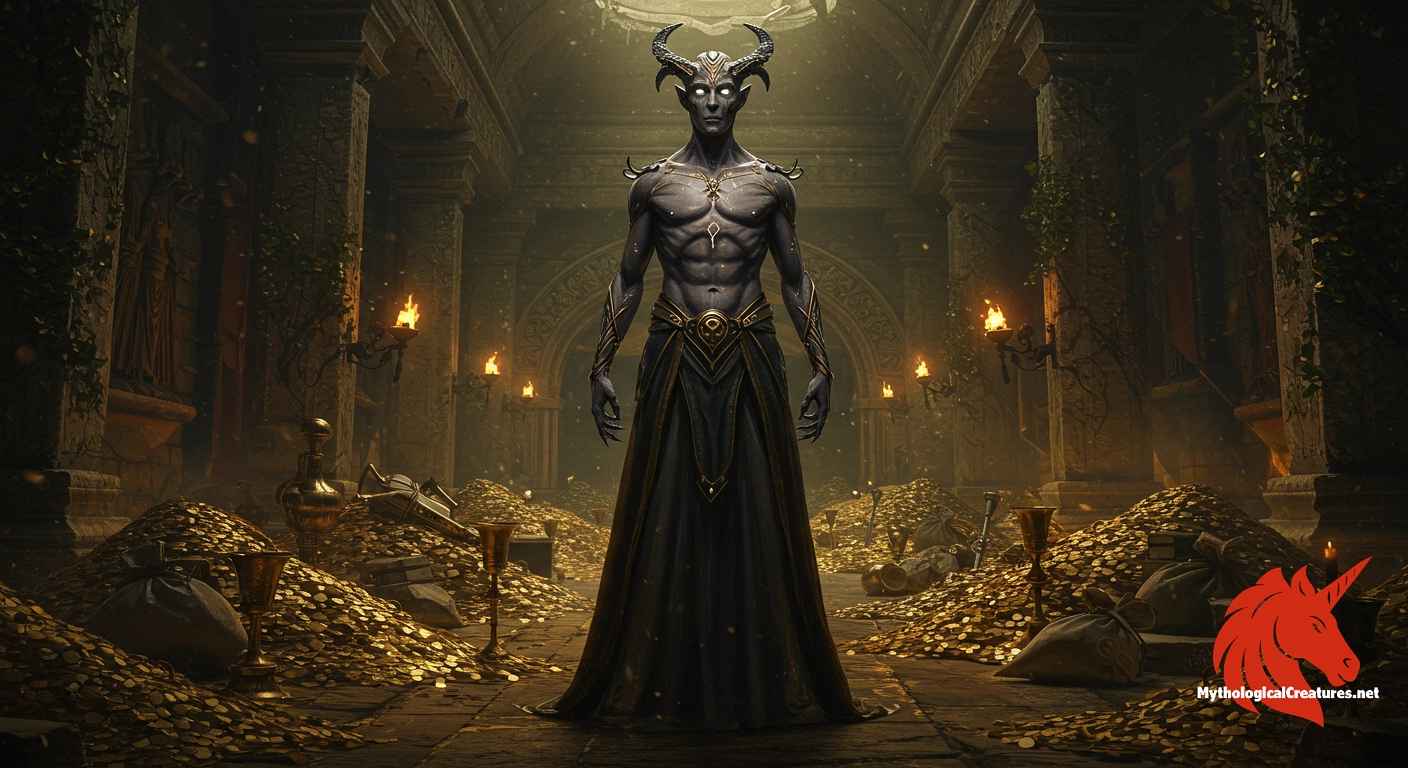Clauneck: Clauneck is an infernal daemon known as the demon of wealth from several renowned European grimoires.

Clauneck
Clauneck - Represents the dual nature of wealth, able to bestow fortune or take it away depending on the summoner’s respect.
Origins & First Encounters
Clauneck is a daemon from Western occult tradition with roots extending into the 18th and 19th centuries. He is known by several names, including Chaunta, Elantiel, Claunt, and Claunth, each reflecting variations that have emerged over time. His first recorded appearance in texts such as the Key of Solomon sets the stage for his reputation as a being capable of both granting and withdrawing wealth. He embodies the paradox of fortune, being as much a giver of riches as he is a reminder of the transience of wealth. His origins are entwined with the esoteric practices of Renaissance magic and the intricate traditions of European demonology. Over time, his legend has grown, emphasising his critical role as a daemon who responds solely to the rituals and respect shown by his summoners. His affiliation with Lucifer and his position among the Servitors of Syrach adds layers to his myth, highlighting a hierarchy within the infernal realms. The cultural backdrop that produced Clauneck reflects a historical preoccupation with the power of wealth and the dangers of avarice. His enduring allure lies in the blend of opulence and caution that he represents, a duality that continues to captivate both scholars and practitioners. Modern occult traditions still reference him as a symbol of economic prosperity and the inherent risks that accompany material ambition.
Source Texts & Tale Variants
Primary sources for Clauneck include influential grimoires such as the Key of Solomon, Grimorium Verum, and Dictionnaire Infernal, each offering a distinctive portrayal of his abilities. In the Key of Solomon, he is introduced under the name Claunth, portrayed as a power capable of transforming ritual tokens into tangible wealth. The Grimorium Verum expands on this image, placing him among the eighteen Servitors of Syrach and accentuating his close ties with Lucifer in bestowing riches. Dictionnaire Infernal further reinforces his status by describing his obedience, which is contingent upon the proper reverence accorded by summoners. Numerous manuscripts, circulating in assorted European regions, reveal subtle differences in his name and the specifics of his abilities. Some variants in the texts highlight his capacity to transport wealth over long distances or to unearth hidden treasures. The diverse accounts illustrate a tradition where oral and scribal transmissions have both shaped and diversified his narrative. Variations in the ritual procedures and the conditions of his summoning serve as a testament to the evolving nature of occult practices. The weight of these sources has contributed to a complex legacy that continues to inspire modern interpretations. The breadth of these accounts demonstrates the powerful pull that wealth—and the magic associated with it—has held over cultural consciousness throughout the ages.
Form & Powers
Clauneck is often envisioned with an imposing yet refined aesthetic, a reflection of his unique dominion over wealth and fortune. Artistic depictions from various grimoires portray him clad in sumptuous robes that feature intricate gold filigree and mystical sigils. His form is generally rendered with an air of nobility, suggesting a regal bearing that is both menacing and alluring. Some illustrations hint at the presence of subtle horns or other demonic accoutrements, elements that are gracefully integrated with symbols of opulence. His eyes are sometimes imagined as reservoirs of molten gold, captivating observers much like treasures in a hidden vault. Interpretations of his stature vary widely, ranging from a towering figure radiating authority to a more mysterious, almost ethereal presence. The interplay of shadow and light in his iconography often employs dark, brooding colours interspersed with bright accents of silver and gold. Every detail in his visage seems meticulously designed to mirror the multifaceted nature of wealth itself. The dynamic quality of his imagery has allowed artists and occultists alike to explore a rich visual vocabulary associated with luxury and power. Despite the variations inherent in his depictions, a consistent theme of grandeur and seductive allure remains central to his character.
Regional Faces
Across different regions, the figure of Clauneck has been adapted to resonate with local cultural and economic narratives, resulting in diverse portrayals. In Italian traditions, for example, his rituals are often enfolded in elaborate ceremonies that echo the sumptuous lifestyles of historic aristocracy. French manuscripts, particularly those drawn from the Grimorium Verum, tend to amplify his role as a harbinger of secret fortunes and hidden treasures. In Eastern European accounts, his persona is intermingled with local superstitions that cast wealth as a force both beneficial and perilous. The variations in his nomenclature across different cultures highlight how linguistic influences have shaped his myth. Some regional narratives present him with a softer, almost benevolent side, where the bestowment of riches comes with a lesson in cautious stewardship. Over the Mediterranean, elements of folklore converge with occult traditions to recast him as a guardian of treasured secrets. The adaptation of his character to reflect local values underscores the interplay between supernatural lore and everyday experiences of economic desire. These regional flavours not only enrich his myth but also demonstrate the adaptability of demonological themes to various cultural landscapes. Such localised interpretations ensure that Clauneck remains a versatile and enduring symbol in the realm of occult mythology.
Cultural Parallels
Within the broad spectrum of mythological figures associated with wealth, Clauneck shares notable parallels with several other enigmatic entities. His role as both a granter and a regulator of fortunes invites a natural comparison to Mammon, a personification of greed and materialism in Christian lore. Like the ancient deity Plutus, his very essence embodies the double-edged nature of prosperity—its ability to both enrich and destroy. He also bears a resemblance to the djinn of Middle Eastern tradition, whose capricious support in matters of wealth mirrors the unpredictable nature of Clauneck’s gifts. Despite these similarities, his unique attribute lies in his obedience to ritualistic commands, marking a more transactional nature as opposed to the capricious independence found in other wealth-associated beings. His affiliation with Lucifer and the explicit hierarchies within the infernal courts further distinguish him from other comparable figures. This structured positioning underscores a blend of servility and power that is distinct within the realm of occult daemons. Comparative reflections across cultures reveal that, while many societies have revered deities or spirits of fortune, Clauneck’s narrative is singular in its emphasis on reciprocal respect through magic. The persistence of such parallels across different mythologies emphasizes the universal human fascination with harnessing the forces of wealth. Ultimately, the study of his character reinforces the idea that, across various traditions, the pursuit of riches is as much a spiritual and moral journey as it is an economic one.
Legacy & Modern Evolution
Over the centuries, the portrayal of Clauneck has undergone a significant evolution, mirroring changes in societal attitudes towards wealth, power, and the occult. Early grimoires cast him as an unwavering and strict daemon whose favour was a double-edged sword capable of elevating fortunes or precipitating ruin. In more modern contexts, he has become an emblematic figure, representing both the promise and the peril inherent in the pursuit of material success. Contemporary practitioners of the occult often invoke his name as a means to symbolically negotiate the balance between ambition and ethical restraint. His image has permeated artistic and literary circles, inspiring depictions that blend classical demonology with modern notions of financial success and the inherent risks of capitalism. The resurgence of his myth in role-playing games, graphic novels, and underground occult movements speaks to a revitalised interest in the darker aspects of economic desire. This modern reinterpretation allows Clauneck to serve not only as a literal daemon in magical rites but also as a metaphor for modern economic struggles. His legacy has been reframed as a cautionary yet intriguing figure who personifies the eternal interplay between wealth and woe. The shifting narrative of his character reflects an ongoing dialogue about contemporary values, the ethics of ambition, and the transformative power of desire. As both a historical figure and a modern symbol, Clauneck continues to influence discussions on materialism and the costs of prosperity.
Interesting Fact
An intriguing aspect of Clauneck is his dual ability to both bestow and withdraw wealth, reflecting the inherent risks of dabbling in occult financial magic.
Quick Creature Info
Our Mythic Legendary Rating:

Also Sometimes Known As:
Habitat:
Supernatural Powers:
Abilities:
Behavior:
Lore:
Related Creatures, Tales or Lore
- MMammon
- BBelphegor
- PPlutus
References
Discover Another Mythical Legend You May Not Have Heard Of?
Uncover the mysteries of ancient folklore and expand your knowledge of legendary beings from cultures around the world.
Dare to Meet the Pyelepyin Maunghnama....
Mythical Disclaimer: The images and data on this site are derived from various historical and literary sources, but we have found that many myths often have multiple versions and interpretations across references, sometimes contradictory. As a result, these creature depictions are artistic interpretations—imaginative blends of folklore, legend, and a dash of AI guesswork. Because creature descriptions vary widely, our illustrations and accompanying information represent our best effort to honor mythology while bridging creative gaps. Enjoy these interpretations—just remember, we've done our best to respect the stories and validate available data, but in the realm of mythology, details often shift, imagination leads the way, and nothing is ever set in stone!
Curated by the Mythological Creatures Team (rev. May 2025)
